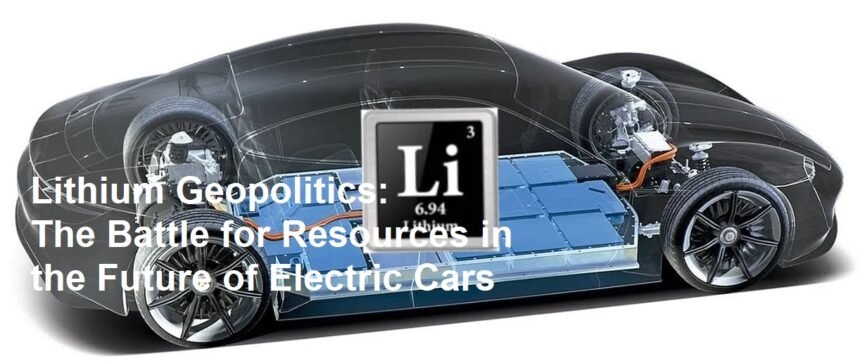Introduction: Why Lithium Matters for the EV Era
Electric vehicles (EVs) are no longer a futuristic concept—they’re the present. From Tesla to BYD, automakers worldwide are racing to electrify their fleets. But behind the shiny cars and green promises lies a critical question: where will the lithium come from?
Lithium, often called “white gold,” is the key ingredient in EV batteries. And as demand skyrockets, geopolitics of lithium and electric vehicles are reshaping international relations, trade, and even climate strategies.
This article unpacks the role of South American lithium mines, the complexities of global energy politics, and the fragility of the EV supply chain. Plus, we’ll share practical tips for consumers, investors, and policymakers who want to understand what’s really at stake.
Lithium and the EV Supply Chain
Why Lithium Is Essential
Lithium-ion batteries power everything from smartphones to Teslas. But EVs need a lot more lithium than gadgets—sometimes over 60 kilograms per car. Without lithium, the dream of mass electric mobility simply can’t happen.
The EV Supply Chain in Focus
The EV supply chain is long and fragile:
- Mining (raw material extraction in South America, Australia, China).
- Processing (refining into battery-grade lithium).
- Manufacturing (battery plants and automakers).
- Recycling (still limited but growing).
Any disruption at one stage—from strikes at a lithium mine to trade restrictions—can delay car production and drive up prices.
Practical Tip for Consumers
If you’re planning to buy an EV:
- Check where your carmaker sources its batteries. Companies transparent about their supply chain are more reliable.
- Look into resale and recycling options. This will become increasingly valuable as battery recycling scales up.
South America: The Lithium Triangle
The Power of the Lithium Triangle
When people talk about South American lithium mines, they’re usually referring to Chile, Argentina, and Bolivia—together known as the Lithium Triangle. This region holds more than half of the world’s lithium reserves.
- Chile: A stable, business-friendly environment, but growing political debates about nationalizing resources.
- Argentina: Huge potential but faces economic instability.
- Bolivia: Massive untapped reserves but limited infrastructure and political hurdles.
Geopolitical Implications
Countries in the Lithium Triangle are aware of their power. Just as oil reshaped global politics in the 20th century, lithium could do the same in the 21st. Some leaders even talk about forming a “Lithium OPEC” to control pricing and supply.
Practical Tip for Investors
- Follow local politics closely. Policy shifts can affect mining contracts overnight.
- Diversify geographically. Don’t rely solely on South America; consider Australia or Canada as part of a balanced resource strategy.
Global Energy Politics and Lithium
Lithium as the New Oil?
The race for lithium is part of broader global energy politics. Countries no longer fight over oil pipelines but over access to battery materials. China currently dominates lithium refining and battery production, giving it strategic leverage.
Meanwhile, the U.S. and Europe are investing billions to secure local supply chains, from funding mining projects to building gigafactories. This competition shapes not just trade policy but also diplomacy and security strategies.
Practical Tip for Policymakers
- Build partnerships, not dependencies. Relying too heavily on one supplier (like China) creates vulnerabilities.
- Encourage recycling. Secondary lithium sources can reduce pressure on imports.
- Support R&D. Alternatives to lithium, like sodium-ion or solid-state batteries, could reduce geopolitical risks in the future.
Challenges in the EV Supply Chain
Risks and Bottlenecks
Even with ambitious policies, the EV supply chain faces challenges:
- Price volatility: Lithium prices have soared in recent years.
- Environmental concerns: Mining operations consume water and disrupt local ecosystems.
- Social issues: Communities near mines often protest exploitation and lack of benefits.
Practical Tip for Automakers
- Be transparent with communities. Fair partnerships can reduce protests and disruptions.
- Invest in vertical integration. Companies like Tesla are moving upstream, securing their own lithium contracts to ensure stability.
The Future of Lithium Geopolitics
Short-Term Outlook
Over the next decade, demand for lithium could quadruple. South America, Australia, and China will remain central players. Expect more trade tensions, resource nationalism, and tech innovation around recycling.
Long-Term Possibilities
Two trends may shift the game:
- Battery recycling—recovering lithium from old batteries could cut reliance on new mining.
- New battery chemistries—if sodium-ion or solid-state batteries scale, lithium’s dominance may decline.
Practical Tip for Everyday Drivers
- Stay updated on EV technology. Battery breakthroughs could affect car prices and performance.
- Consider total ownership cost. Factor in not just purchase price but also battery replacement, recycling, and resale value.
Conclusion: Lithium as the New Battleground
The story of geopolitics of lithium and electric vehicles mirrors the history of oil. From South American lithium mines to global energy politics, every link in the EV supply chain is shaping the future of mobility.
As the world shifts to cleaner transportation, the competition for lithium will decide not just who leads the EV market, but also who controls the next era of global energy.
Now it’s your turn: Do you think lithium will remain the “new oil,” or will alternative technologies make it less important? Share your thoughts in the comments below!












